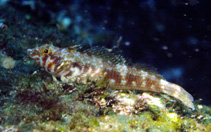| Family: |
Tripterygiidae (Triplefin blennies), subfamily: Tripterygiinae |
| Max. size: |
8.9 cm SL (male/unsexed) |
| Environment: |
reef-associated; marine; depth range 1 - 12 m |
| Distribution: |
Southeast Pacific: endemic to the Galapagos Islands. |
| Diagnosis: |
|
| Biology: |
Adults live in rocky reefs, boulder strewn slopes and walls (Ref. 5227). Males occupy territories of less than 50 cm diameter, on vertical or overhanging rock faces, from November through February. Females leave the territory after spawning, but the male continues to court and to spawn with other females in his territory while guarding the previously spawned egg masses from predators like wrasses and gobies (Ref. 28023). Eggs are hemispherical and covered with numerous sticky threads that anchor them in the algae on the nesting sites (Ref. 240). Larvae are planktonic which occur primarily in shallow, nearshore waters (Ref. 94114). |
| IUCN Red List Status: |
Least Concern (LC); Date assessed: 16 September 2022 Ref. (130435)
|
| Threat to humans: |
harmless |
Source and more info: www.fishbase.org. For personal, classroom, and other internal use only. Not for publication.

